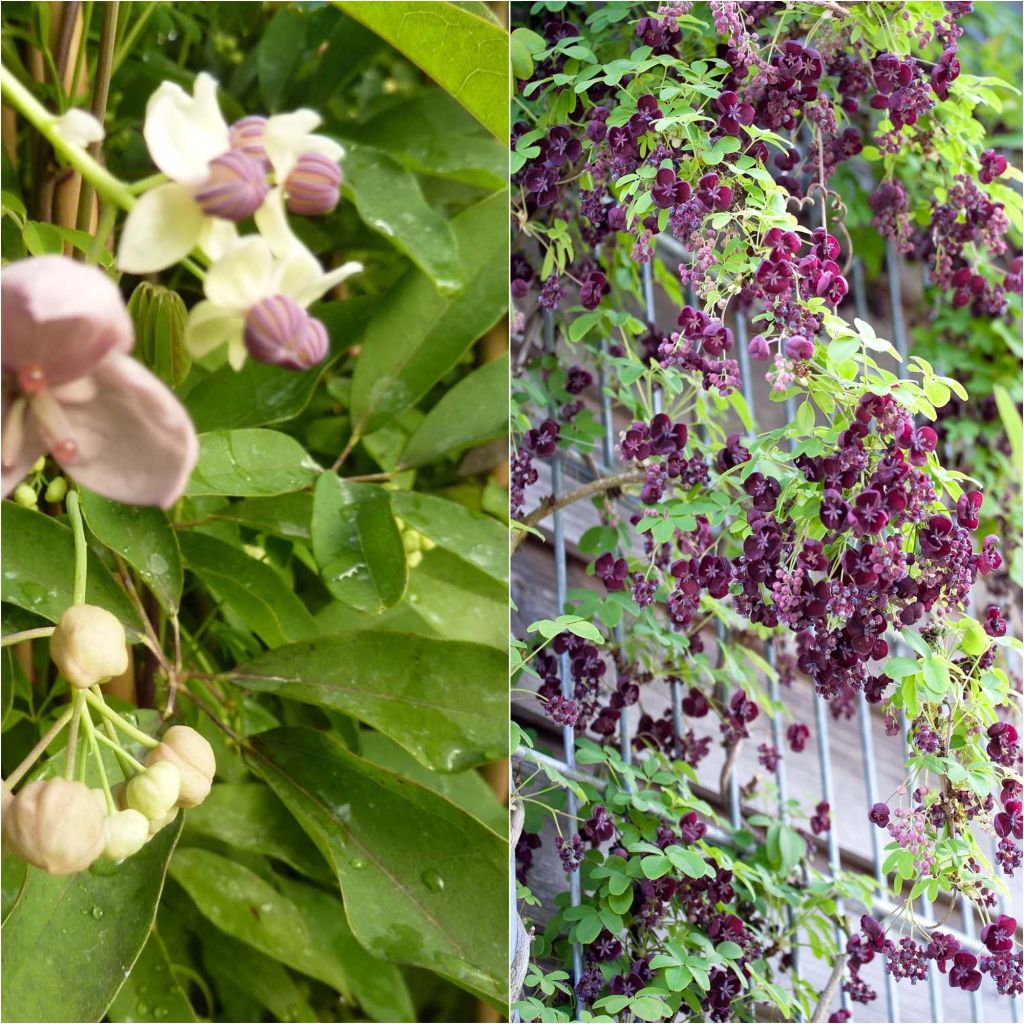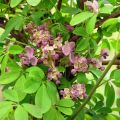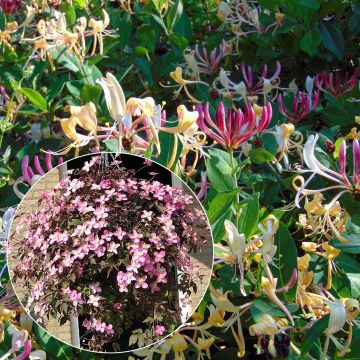

Two Akebia Collection - Chocolate Vine
Two Akebia Collection - Chocolate Vine
Akebia quinata, quinata Silver Bells
Chocolate Vine, Five-leaf Akebia
The akebias are of good quality but they don't grow as much as I wanted. In spring, late frost does a lot of harm. The plant only grows in spring. I have very clayey soil and that is surely the reason for this.
Celine10, 25/01/2025
This item cannot be shipped to the selected country
Delivery charge from €5.90
More information
Schedule delivery date,
and select date in basket
This plant carries a 6 months recovery warranty
More information
We guarantee the quality of our plants for a full growing cycle, and will replace at our expense any plant that fails to recover under normal climatic and planting conditions.
From €5.90 for pickup delivery and €6.90 for home delivery
Express home delivery from €8.90.

Does this plant fit my garden?
Set up your Plantfit profile →
Collection items (2 plants)
Description
A duo of Akebia quinata, also known as Five-leafed Akebia, composed of the classic Akebia quinata, with deep purple flowers, and its variety Silver Bells, with mauve and white-silver flowers. These are original and vigorous climbing plants, adorned with decorative deciduous foliage and fragrant spring flowers grouped in clusters. Their long voluble stems wrap around any support available to them. Although slow to establish, these creepers will enthusiastically cover a pergola, a canopy, or take over a slightly sad old hedge...
This duo is composed of a classic Aquebia quinata and a 5-leafed Akebia 'Silver Bells'.
Akebias, native to China, Korea, and Japan, were introduced to Europe in the mid-19th century, where they enjoyed great success. After falling out of fashion for a few decades, they are making a comeback today, especially since they are both decorative climbers, easy to grow in any deep soil and resistant to cold (down to at least -15°C (5°F) for a well-established specimen). These plants belong to the Lardizabalaceae family, just like the Holboellia.
The long, round, and voluble stems of Akebia quinata can exceed 8m (26ft) on a mature plant under optimal conditions. It takes 3 to 5 years for the plant to establish itself, after which it can produce stems several meters long in a single season. They are adorned with palmate leaves, divided into 5 ovate leaflets, dark green on the upper side and blue-green on the underside, sometimes tinged with purple in winter. They are attached to the stem by a long petiole of about 10cm (4in). In mild climates, this foliage is semi-evergreen in winter, while it is deciduous everywhere else. Flowering occurs in spring, in April-May depending on the climate. An Akebia plant will bear both male and female flower clusters, but separately. The highly fragrant flowers appear in the axils of the leaves, grouped in short clusters. The male flowers are arranged in pendulous racemes of 4 to 15 units, while the female flowers, 2 to 3cm (1in) in diameter, are grouped in clusters of 3 or 4 units. They all consist of a calyx with 3 rounded sepals, from which the fertile parts emerge: stamens in male flowers, or a pistil in female flowers. In classic Akebia quinata, the calyx is wine- to chocolate-coloured. In 'Silver Bells', the sepals are white-silver. This flowering emits a delicious scent reminiscent of pastries, with a more or less vanilla-chocolate aroma. Fruit formation is more common in warm regions, and pollination requires the presence of two different plants. The oval fruits measure 7cm (3in) in length and contain an edible, white and gelatinous pulp, with numerous bitter seeds. These fruits ripen in September-October.
The lightness of their foliage and leaves allows Akebia quinata to climb in a hedge or on a tree, or as a complement to a climbing rose (Treasure Trove, Mermaid), or a vigorous clematis (Clematis montana, terniflora). They are elegant and fragrant plants that can also be used to cover a canopy or a pergola, as they provide shade on a terrace in summer while allowing sunlight in winter.
Report an error about the product description
Plant habit
Flowering
Foliage
Botanical data
Akebia
quinata, quinata Silver Bells
Lardizabalaceae
Chocolate Vine, Five-leaf Akebia
East Asia
Other Climber pairs
Planting and care
Undemanding, the Akebia quinata adapts to all types of deep soil with a preference for rich and well-drained, neutral or acidic soil. The presence of non-excessive limestone is well tolerated. It appreciates sun or partial shade (however, avoid full sun in southern regions). Monitor watering during the first two years following planting, especially if the summer is dry. Apply organic fertiliser when planting, then every spring. It does not require pruning, but will benefit from a spring-clean after flowering to remove the weaker branches. With significant growth, from 6 to 8m (20 to 26ft), it withstands shaping pruning and can even be cut back to the base.
Planting period
Intended location
Care
-
, onOrder confirmed
Reply from on Promesse de fleurs
Haven't found what you were looking for?
Hardiness is the lowest winter temperature a plant can endure without suffering serious damage or even dying. However, hardiness is affected by location (a sheltered area, such as a patio), protection (winter cover) and soil type (hardiness is improved by well-drained soil).

Photo Sharing Terms & Conditions
In order to encourage gardeners to interact and share their experiences, Promesse de fleurs offers various media enabling content to be uploaded onto its Site - in particular via the ‘Photo sharing’ module.
The User agrees to refrain from:
- Posting any content that is illegal, prejudicial, insulting, racist, inciteful to hatred, revisionist, contrary to public decency, that infringes on privacy or on the privacy rights of third parties, in particular the publicity rights of persons and goods, intellectual property rights, or the right to privacy.
- Submitting content on behalf of a third party;
- Impersonate the identity of a third party and/or publish any personal information about a third party;
In general, the User undertakes to refrain from any unethical behaviour.
All Content (in particular text, comments, files, images, photos, videos, creative works, etc.), which may be subject to property or intellectual property rights, image or other private rights, shall remain the property of the User, subject to the limited rights granted by the terms of the licence granted by Promesse de fleurs as stated below. Users are at liberty to publish or not to publish such Content on the Site, notably via the ‘Photo Sharing’ facility, and accept that this Content shall be made public and freely accessible, notably on the Internet.
Users further acknowledge, undertake to have ,and guarantee that they hold all necessary rights and permissions to publish such material on the Site, in particular with regard to the legislation in force pertaining to any privacy, property, intellectual property, image, or contractual rights, or rights of any other nature. By publishing such Content on the Site, Users acknowledge accepting full liability as publishers of the Content within the meaning of the law, and grant Promesse de fleurs, free of charge, an inclusive, worldwide licence for the said Content for the entire duration of its publication, including all reproduction, representation, up/downloading, displaying, performing, transmission, and storage rights.
Users also grant permission for their name to be linked to the Content and accept that this link may not always be made available.
By engaging in posting material, Users consent to their Content becoming automatically accessible on the Internet, in particular on other sites and/or blogs and/or web pages of the Promesse de fleurs site, including in particular social pages and the Promesse de fleurs catalogue.
Users may secure the removal of entrusted content free of charge by issuing a simple request via our contact form.
The flowering period indicated on our website applies to countries and regions located in USDA zone 8 (France, the United Kingdom, Ireland, the Netherlands, etc.)
It will vary according to where you live:
- In zones 9 to 10 (Italy, Spain, Greece, etc.), flowering will occur about 2 to 4 weeks earlier.
- In zones 6 to 7 (Germany, Poland, Slovenia, and lower mountainous regions), flowering will be delayed by 2 to 3 weeks.
- In zone 5 (Central Europe, Scandinavia), blooming will be delayed by 3 to 5 weeks.
In temperate climates, pruning of spring-flowering shrubs (forsythia, spireas, etc.) should be done just after flowering.
Pruning of summer-flowering shrubs (Indian Lilac, Perovskia, etc.) can be done in winter or spring.
In cold regions as well as with frost-sensitive plants, avoid pruning too early when severe frosts may still occur.
The planting period indicated on our website applies to countries and regions located in USDA zone 8 (France, United Kingdom, Ireland, Netherlands).
It will vary according to where you live:
- In Mediterranean zones (Marseille, Madrid, Milan, etc.), autumn and winter are the best planting periods.
- In continental zones (Strasbourg, Munich, Vienna, etc.), delay planting by 2 to 3 weeks in spring and bring it forward by 2 to 4 weeks in autumn.
- In mountainous regions (the Alps, Pyrenees, Carpathians, etc.), it is best to plant in late spring (May-June) or late summer (August-September).
The harvesting period indicated on our website applies to countries and regions in USDA zone 8 (France, England, Ireland, the Netherlands).
In colder areas (Scandinavia, Poland, Austria...) fruit and vegetable harvests are likely to be delayed by 3-4 weeks.
In warmer areas (Italy, Spain, Greece, etc.), harvesting will probably take place earlier, depending on weather conditions.
The sowing periods indicated on our website apply to countries and regions within USDA Zone 8 (France, UK, Ireland, Netherlands).
In colder areas (Scandinavia, Poland, Austria...), delay any outdoor sowing by 3-4 weeks, or sow under glass.
In warmer climes (Italy, Spain, Greece, etc.), bring outdoor sowing forward by a few weeks.















































